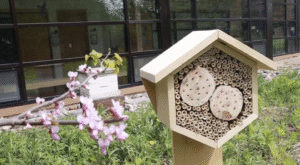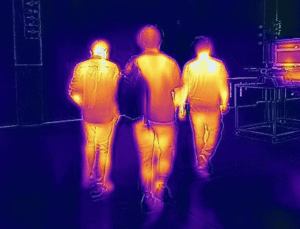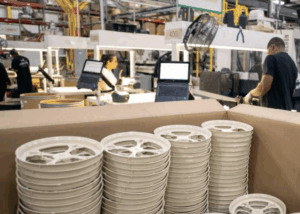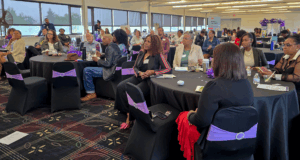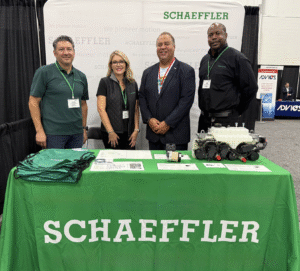
- Kim Kisner
- Business
- 08/18/2022
Paulina Reyes Shares the Vision and Leads the ROSSETTI Sustainability Lab in Detroit
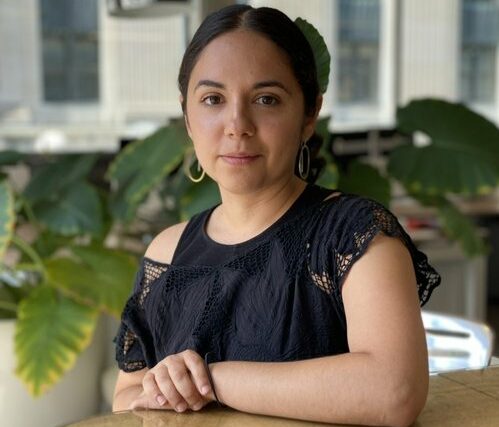
SBN Detroit spoke with Paulina Reyes, a registered architect, and designer at ROSSETTI who leads the ROSSETTI Sustainability Lab.
In addition to her current role at ROSSETTI, Reyes possesses a dedicated background in design-based research, community outreach, and the development of pedagogical efforts connecting cultural programming with the tools of architecture and urbanism. She acted as Project Designer-Manager for Estudio Teddy Cruz + Fonna Forman, leading architectural and urban projects across the US-Mexico border, including fieldwork, and cross-border internship programming.
Sustainability has remained a focus of her work as a previous Design Fellow with the University of Michigan and Fulbright recipient in which she developed research on water sustainability in the context of self-governance and low-income public housing in Mexico City.
The ROSSETTI Sustainability Action Plan calls for embracing and integrating sustainability practices in every facet of their work, believing that prioritizing sustainability is not just a mantra; it offers a vision forward in a rapidly changing world as a means to educate, innovate, and push their work farther than ever before.
Q: Please share the sustainability practices and work ROSSETTI has in place.
A: Sustainability has been a feature of our work for some time. We have several past LEED projects that demonstrate the impact of sustainable design. Louis Armstrong Stadium, for example, is the world’s first naturally ventilated stadium, certified as LEED Silver, and it also won the AIA Detroit Building Award with recognition for sustainability.
The UCLA Health Training Center, the training facility for the Los Angeles Lakers, achieved LEED Platinum through innovative use of solar mitigation strategies, including vertical shading that doubles as signage and a PV solar array that reduces energy consumption by 30%.
The particular inflection of sustainability through sports work is an interesting one, as sports projects by nature are large civic projects that reach huge numbers of people, and hinge specifically on supporting the performance of elite athletes, their health, and well-being.
At ROSSETTI, we are interested in furthering this connection with sports and sustainability in addition to our work at large.
Q: What are your short-term and long-term goals when it comes to sustainability?
A: One short-term goal is to simply shift awareness and culture around environmental impact. Even just being conversant in the basic tenets of sustainability can help designers and clients alike think differently about our approach and how we define value for a project.
Like many others, we have long-term goals to address and reduce emissions in a big way. Most of our clients these days have ambitious goals and mission statements around reducing or even eliminating emissions within the next few decades. Given that this is easily within the lifespan of our projects, this requires that we address emissions (both operational and embodied) as drivers in our design process from the beginning.
GHG (greenhouse gas) emissions are the primary source of global climate change and present an easily quantifiable metric for benchmarking and evaluating success. I would like to see ROSSETTI’s projects take on the challenge of benchmarking, measuring, and reducing emissions in all of our projects moving forward.
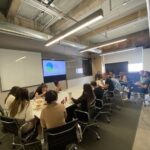
Q: What is the Sustainability Lab?
A: Initially launched in March 2021, the ROSSETTI Sustainability Lab is represented by an interdisciplinary array of staff members from across our office, from design to marketing to project management. We meet on a biweekly basis to discuss ongoing initiatives, and outreach to others in the field. A core group of our members works on advancing various sustainability efforts in the office. We also have a lively Zoom group chat!
Q: How do your sustainability practices come into play when choosing vendors?
A: We prefer to work with vendors that prioritize sustainability in their products. We work with reps like Susan Hall (Eco Surroundings) who only represent sustainable materials like Plyboo, Durat, Baux, DuraPalm, and more.
Luckily, a lot of industries, particularly for interior finishes like carpet or porcelain tile are already headed in that direction.
We are consistently meeting with vendors to see what’s new and identify projects that can support our client’s sustainability goals, including LEED certification.
Q: What about material choices?
A: As a principle, we look to specify materials that are responsible, durable, and locally sourced.
Some examples include Interface Carpet, Unika Vaev (acoustic materials), and Fireclay, which is made in the USA with zero waste and mindful manufacturing. We also work with Haworth, who does a lot of recycling/reuse of material and recently earned zero waste to landfill status and just launched a more rapidly biodegradable textile.
We try to avoid materials that off-gas or contain harmful chemicals like VOCs (volatile organic compounds), including epoxy or vinyl. Specifying more sustainable materials can also support other goals for clients, for example, more durable finishes or furniture that don’t need replacement as often, or local materials which reduce lead time.
Q: Beyond vendors and material choices – what else do you look at?
A: When it comes to materials, whether interior finishes or building structure, embodied carbon is also an extremely important metric and one which we are looking more into. There currently exist many avenues for measuring embodied carbon, software like EC3 or Tally, or environmental product declarations (EPDs) for specific products or industries.
Beyond that, water use, energy use, and waste production are also key metrics for evaluating the sustainability of our projects.
Q: ROSSETTI believes that sustainability is key to client success – please elaborate.
A: Sustainability, beyond being a social imperative, is quite simply put, good for business. Sustainable buildings offer a host of financial benefits to clients: operational savings, higher sale or rental value, lower asset risk, and insurance premiums.
To give an example, the PV solar array installed on the LEED Platinum Los Angeles Lakers practice facility not only offsets 12.6 million pounds of carbon dioxide annually but saves the Lakers $38,000 a year in operational costs.
There is also obviously a broader value proposition to sustainability that includes human health and well-being, community value, and experiential opportunities to connect buildings with the environment.
We should be making clear to our clients that is sustainability not just about making a change, but an opportunity that they can’t pass up.
Q: What is the Return on Design™ Process
A: The Return on Design™ process is our signature, strategic approach to design that addresses our client’s underlying business goals by leveraging the power of data. We draw on the comprehensive data of industry benchmarking and past work to create financial projections for how design interventions can improve revenue and achieve payback within a reasonable period. ROD™ is scalable to each project and can include market studies, benchmarking, holistic master planning, identification, and in-depth pro forma with ROI projections.
ROD™ provides an ideal framework for quantifying the value of sustainability ROI and we are working to develop this further in the coming year.
Q: Are you pleased with the progress and impact you’ve been able to make so far?
A: I think we’ve been able to make incredible progress over the last year at ROSSETTI.
We have about 30 members and counting in our Sustainability Lab. With the help of lab members, we have a lot of research in the works including energy modeling, carbon accounting, responsible material sourcing, and sustainability ROD™. We’ve participated in several sustainability conferences over the past year including the Mass Timber Conference in Portland and the Green Sports Alliance in Minneapolis.
Sustainability is an easy sell to most designers, especially younger designers in our office. We’ve already begun to tap into an incredible passion for sustainability among our staff and are actively feeding that into actionable work for our billable projects.
Q: What are the biggest challenges?
A: I think one of the biggest challenges is in communicating the value proposition of sustainability to clients, ensuring that the message comes early and clients understand the role it plays in a project.
Similarly, another challenge is in maintaining the integrity of the design throughout the project. Sustainable systems, materials, and approaches can often come with a higher up-front cost even if they pay out in the longer term or provide value in other ways. So when projects (as they often do) experience delays or cost overruns, these items can often be the first on the chopping block.
But again, I think this comes back to effective communication with the client, early and often. The more that we can integrate sustainability as a fundamental and mutually reinforcing driver of the project goals upfront, the less tenuous it becomes.
Q: What are the most impactful things designers and developers can do to make a difference?
A: I always return to the H.L. Mencken quote that “for every complex problem, there is an answer that is clear, simple, and wrong.” Climate change is probably the most complex, intractable challenge of our generation, which makes it all the more important that we abandon the idea that there exists a silver bullet to solve it.
I would say start with what you know but adopt a growth mindset of continual self-education and be willing to question assumed wisdom, including your own. Adopting a sustainable mindset often involves diving deeper and embracing the nuance and contradiction of any single answer or approach.
Be ambitious in scope but create achievable and quantifiable goals to establish traction.
Lastly, be conversant in the language and values of your clients, and understand what drives them, because that will enable you to be all the more effective in framing sustainability as intrinsic to their goals.
Kim Kisner
- All
- Business
- Community
- Education
- Events

Schaeffler is a global automotive and industrial supplier with operations in Southeast Michigan, where it works across the region’s manufacturing and supplier network. As sustainability, decarbonization and supply chain resilience become central to how products are designed and sourced, the region’s role in shaping next-generation manufacturing continues to evolve. SBN Detroit interviewed Courtney Quenneville, who oversees supplier sustainability, to discuss the realities of sustainable sourcing, what decarbonizing a...
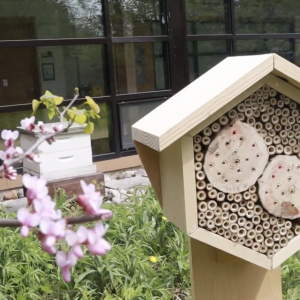
Pollinators are essential to Michigan’s ecosystems, food systems, and long-term environmental resilience — yet they face increasing threats from habitat loss, pesticides, disease, and climate change. As Southeast Michigan looks for scalable, science-based approaches to ecological stewardship, the University of Michigan-Dearborn has emerged as a voice in pollinator conservation, sustainability, and community education. SBN Detroit interviewed Dr. David Susko, Associate Professor of Biology and Chair of Biology in...
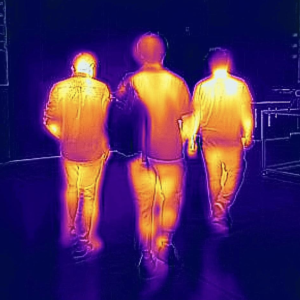
ThermoVerse is a Detroit-based urban innovation startup founded by engineer and researcher Shantonio Birch. The company’s work centers on advanced thermal energy storage and people-focused building technologies that reduce waste, stabilize indoor environments, and free up electrical capacity. SBN Detroit interviewed Birch about the future of grid resiliency, energy equity, and why Southeast Michigan is positioned to lead in next-generation smart city innovation. Q: What is the impetus...


